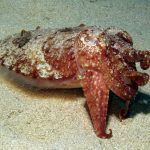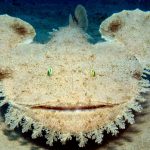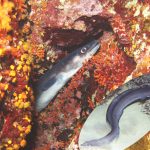Bonellia viridis, the Green Spoonworm (a.k.a. Green Bonellia), is a wide-ranging marine worm species found all along the north-eastern coast of the Atlantic Ocean and the entire Mediterranean Sea, thus also around the Maltese Islands. It is quite noted for displaying exceptional sexual dimorphism (the male being extremely smaller than the female) and for the biocidal properties of a pigment in its skin.
The genus name Bonellia was first described by the Turin doctor Luigi Rolando in 1821, who named it in honour of his friend, the Italian ornithologist, entomologist and collector Franco Andrea Bonelli (10 November 1784 – 18 November 1830). The specific name viridis derives from Latin and means green, evidently denoting the green colour of the body.
The genus Bonellia belongs to the family Bonelliidae, order Bonelliida, class Echiura, phylum Annelida and kingdom Animalia.
The pale to dark-green female, with a 15 cm-long, round or sausage-shaped body, lives on the sea bottom at a depth of 10 to 100 metres. The Green Spoonworm conceals itself by burrowing in gravel or hiding in rock crevasses. Otherwise, it inhabits burrows abandoned by other animals.
Bonellia viridis has two anchoring hooks underneath its body and an extensible feeding proboscis up to 10 times its body-length, thus 1.5 metres long. It is mainly a detritivore, feeding also on small animals. The male is rarely observed: it has a flat, unpigmented body which grows to only 1 to 3 mm, taken up mostly by reproductive organs and devoid of other structures. The male lives on or inside the body of a female.
The adult Green Spoonworm female produces a vivid green pigment in its skin, known as bonellin. This chemical, concentrated mostly in the proboscis, is highly toxic to other organisms, capable of paralyzing small animals. In the presence of light, bonellin is a very effective biocide, killing bacteria, larva of other organisms, and red blood cells in laboratory tests. It is currently being investigated as a possible model for novel antibiotics.
Most larvae, however, once they come in contact with the bonellin in the skin of an adult female, its body or its roving, bonellin-rich proboscis, they are masculinised by this exposure. The chemical causes these larvae to develop into the tiny males, which cling to the female’s body or are sucked inside it by the feeding tube, to spend the remainder of their lives inside her genital sac, producing sperm to fertilize her eggs, reliant on her for all other needs.
The sex of a Green Spoonworm is thus determined by external, environmental factors (the presence or absence of bonellin), not by internal, genetic factors (chromosomes), as is the case with most other sexually-differentiated organisms. This environmental sex determination helps Bonellia viridis populations respond to the availability of burrows.
The photo of this Green Spoonworm was taken at a depth of 58m at Reqqa Point on Gozo’s north coast.
Photo taken by Brian Azzopardi









